The Effect of Residual Solvent in Carbon−Based Filler Reinforced Polymer Coating on the Curing Properties, Mechanical and Corrosive Behaviour
Abstract
:1. Introduction
2. Materials and Methods
3. Results
3.1. Characterization of the Curing Degree of GO−EP U and GO−EP MS Nanocomposite Coatings
3.2. Characterization of the Dispersion Levels of GO−EP U and GO−EP MS Nanocomposites
3.3. Characterization of the Mechanical Properties of GO−EP U and GO−EP MS
3.4. Corrosion Protective Properties of GO−EP U and GO−EP MS
3.4.1. Pull−off Adhesion Test
3.4.2. Electrochemical Impedance Spectroscopy (EIS)
4. Conclusions
Author Contributions
Funding
Institutional Review Board Statement
Informed Consent Statement
Data Availability Statement
Acknowledgments
Conflicts of Interest
References
- Zheng, H.; Shao, Y.; Wang, Y.; Meng, G.; Liu, B. Reinforcing the corrosion protection property of epoxy coating by using graphene oxide−poly(urea−formaldehyde) composites. Corros. Sci. 2017, 123, 267–277. [Google Scholar] [CrossRef]
- Li, L.; Zeng, C.; Ai, L.; Jiang, J. Synthesis of reduced graphene oxide−iron nanoparticles with superior enzyme−mimetic activity for biosensing application. J. Alloys Compd. 2015, 639, 470–477. [Google Scholar] [CrossRef]
- Prusty, R.K.; Ghosh, S.K.; Rathore, D.K.; Ray, B.C. Reinforcement effect of graphene oxide in glass fibre/epoxy composites at in−situ elevated temperature environments: An emphasis on graphene oxide content. Compos. Part A Appl. Sci. Manuf. 2017, 95, 40–53. [Google Scholar] [CrossRef]
- Scott, B.J.; Scott, S.V.; Jonathan, S.A.; Arend, M.Z.; Jeevak, M.P.; Harold, G.C.; Paul, L.M. Impermeable Atomic Membranes from Graphene Sheets. Nano Lett. 2008, 8, 2458–2462. [Google Scholar]
- Wang, M.H.; Li, Q.; Li, X.; Liu, Y.; Fan, L.Z. Effect of oxygen−containing functional groups in epoxy/reduced graphene oxide composite coatings on corrosion protection and antimicrobial properties. Appl. Surf. Sci. 2018, 448, 351–361. [Google Scholar] [CrossRef]
- Ramezanzadeh, B.; Niroumandrad, S.; Ahmadi, A.; Mahdavian, M.; Mohamadzadeh Moghadam, M.H. Enhancement of barrier and corrosion protection performance of an epoxy coating through the wet transfer of amino−functionalized graphene oxide. Corros. Sci. 2016, 103, 283–304. [Google Scholar] [CrossRef]
- Rajabi, M.; Rashed, G.R.; Zaarei, D. Assessment of graphene oxide/epoxy nanocomposite as corrosion resistance coating on carbon steel. Corros. Eng. Sci. Technol. 2015, 50, 509–516. [Google Scholar] [CrossRef]
- Noorhafanita, N.; Sahrim, A.; Chia, C.H.; Huang, N.M. Mechanical and Thermal Properties of Graphene Oxide Filled Epoxy Nanocomposites. Sains Malays. 2014, 43, 603–609. [Google Scholar]
- Shokrieh, M.M.; Hosseinkhani, M.R.; Naimi−Jamal, M.R.; Tourani, H. Nanoindentation and nanoscratch investigations on graphene−based nanocomposites. Polym. Test. 2013, 32, 45–51. [Google Scholar] [CrossRef]
- Deng, C.; Jiang, J.; Liu, F. Influence of graphene oxide coatings on carbon fiber by ultrasonically assisted electrophoretic deposition on its composite interfacial property. Surf. Coat. Technol. 2015, 272, 176–181. [Google Scholar] [CrossRef]
- An, X.; Simmons, T.; Shah, R.; Wolfe, C. Stable Aqueous Dispersions of Noncovalently Functionalized Graphene from Graphite and their Multifunctional High−Performance Applications. Nano Lett. 2010, 10, 4295–4301. [Google Scholar] [CrossRef] [PubMed]
- Ni, Y.; Chen, L.; Teng, K.; Shi, J.; Qian, X.; Xu, Z.; Tian, X.; Hu, C.; Ma, M. Superior Mechanical Properties of Epoxy Composites Reinforced by 3D Interconnected Graphene Skeleton. ACS Appl. Mater. Interfaces 2015, 7, 11583–11591. [Google Scholar] [CrossRef] [PubMed]
- Wang, X.; Jin, J.; Song, M. An investigation of the mechanism of graphene toughening epoxy. Carbon N. Y. 2013, 65, 324–333. [Google Scholar] [CrossRef] [Green Version]
- Zheng, L.; Rongguo, W.; Robert, J.Y.; Libo, D.; Fan, Y.; Lifeng, H.; Weicheng, J.; Wenbo, L. Control of the functionality of graphene oxide for its application in epoxy nanocomposites. Polymer 2013, 54, 6437–6446. [Google Scholar]
- Kim, H.M.; Lee, J.K.; Lee, H.S. Transparent and high gas barrier films based on poly(vinyl alcohol)/graphene oxide composites. Thin Solid Films 2011, 519, 7766–7771. [Google Scholar] [CrossRef]
- Barroso−Bujans, F.; Cerveny, S.; Verdejo, R.; Del Val, J.J.; Alberdi, J.M.; Alegria, A.; Colmenero, J. Permanent adsorption of organic solvents in graphite oxide and its effect on the thermal exfoliation. Carbon 2010, 48, 1079–1087. [Google Scholar] [CrossRef]
- Wang, B.; Wilkes, G.L. Novel hybrid inorganic−organic abrasion−resistant coatings prepared by a sol−gel process. J. Macromol. Sci. Part A 1994, 31, 249–260. [Google Scholar] [CrossRef]
- Kuilla, T.; Bhadra, S.; Yao, D.H.; Kim, N.H.; Bose, S.; Lee, J.H. Recent advances in graphene−based polymer composites. Prog. Polym. Sci. 2010, 35, 1350–1375. [Google Scholar] [CrossRef]
- Loos, M.R.; Coelho, L.A.F.; Pezzin, S.H. The Effect of Acetone Addition on the Properties of Epoxy. Polímeros 2008, 18, 76–80. [Google Scholar] [CrossRef] [Green Version]
- Hong, S.G.; Wu, C.S. DSC and FTIR analysis of the curing behaviours of epoxy/DICY/solvent open systems. Thermochim. Acta 1997, 316, 167–175. [Google Scholar] [CrossRef]
- Sun, J.; Li, H.; Wang, C.; Yuan, D.; Stubbs, L.P.; He, C. The Effect of Residual Solvent N, N′−Dimethylformamide on the Curing Reaction and Mechanical Properties of Epoxy and Lignin Epoxy Composites. Macromol. Chem. Phys. 2016, 217, 1065–1073. [Google Scholar] [CrossRef]
- George, W. Handbook of Fillers, 4th ed.; ChemTec Publishing: Toronto, ON, Canada, 2016; pp. 467–531. [Google Scholar]
- Yi, C.; Rostron, P.; Vahdati, N.; Gunister, E.; Alfantazi, A. Curing kinetics and mechanical properties of epoxy−based coatings: The influence of added solvent. Prog. Org. Coat. 2018, 124, 165–174. [Google Scholar] [CrossRef]
- Lau, K.T.; Lu, M.; Lam, C.K.; Cheung, H.Y.; Sheng, F.L.; Li, H.L. Thermal and mechanical properties of single−walled carbon nanotube bundle−reinforced epoxy nanocomposites: The role of solvent for nanotube dispersion. Compos. Sci. Technol. 2005, 65, 719–725. [Google Scholar] [CrossRef]
- Bilyeu, B.; Brostow, W.; Menard, K.P. Epoxy thermosets and their applications II: Thermal analysis. J. Mater. Educ. 2000, 22, 107–129. [Google Scholar]
- Wang, X.; Qi, X.; Lin, Z.; Battocchi, D. Graphene reinforced composites as protective coatings for oil and gas pipelines. Nanomaterials 2018, 8, 1005. [Google Scholar] [CrossRef] [PubMed] [Green Version]
- Qiu, S.; Li, W.; Zheng, W.; Zhao, H.; Wang, L. Synergistic effect of polypyrrole-intercalated graphene for enhanced corrosion protection of aqueous coating in 3.5% NaCl solution. ACS Appl. Mater. Interfaces 2017, 9, 34294–34304. [Google Scholar] [CrossRef] [PubMed]
- Li, Z.; Zhang, W.; Luo, Y.; Yang, J.; Hou, J.G. How Graphene Is Cut upon Oxidation. J. Am. Chem. Soc. 2009, 131, 6320–6321. [Google Scholar] [CrossRef] [Green Version]
- Dreyer, D.R.; Park, S.; Bielawski, W.; Ruoff, R.S. The chemistry of graphene oxide. Chem. Soc. Rev. 2010, 39, 228–240. [Google Scholar] [CrossRef]
- Kilic, U.; Sherif, M.M.; Ozbulut, O.E. Tensile properties of graphene nanoplatelets/epoxy composites fabricated by various dispersion techniques. Polym. Test. 2019, 76, 181–191. [Google Scholar] [CrossRef]
- Yoo, B.M.; Shin, H.J.; Yoon, H.W.; Park, H.B. Graphene and graphene oxide and their uses in barrier polymers. J. Appl. Polym. Sci 2014, 131, 1–23. [Google Scholar] [CrossRef]
- Amirudin, A.; Thieny, D. Application of electrochemical impedance spectroscopy to study the degradation of polymer-coated metals. Prog. Org. Coat. 1995, 26, 1–28. [Google Scholar] [CrossRef]
- Liu, Y.; Wang, J.; Liu, L.; Li, Y.; Wang, F. Study of the failure mechanism of an epoxy coating system under high hydrostatic pressure. Corros. Sci. 2013, 74, 59–70. [Google Scholar] [CrossRef]
- Tator, B.T.; Lanterman, R. Coating Deterioration—A Mechanistic Overview. In Proceedings of the Corrosion 2016, Vancouver, BC, Canada, 6–10 March 2018. [Google Scholar]
- Hammouda, N.; Belmokre, K. Study of the Behavior of an Organic Coating Applied on Algerian Oil Tanker in Seawater. Int. J. Mater. Metall. Eng. 2015, 9, 219–224. [Google Scholar]
- Ramezanzadeh, B.; Attar, M.M.; Farzam, M. A study on the anticorrosion performance of the epoxy–polyamide nanocomposites containing ZnO nanoparticles. Prog. Org. Coat. 2011, 72, 410–422. [Google Scholar] [CrossRef]
- Lu, F.; Song, B.; He, P.; Wang, J. Electrochemical impedance spectroscopy (EIS) study on the degradation of acrylic polyurethane coatings. RCS Adv. 2017, 7, 13742–13748. [Google Scholar] [CrossRef] [Green Version]
- Yu, H.L.; Lin, Y.Y.; Lin, C.H.; Chan, C.C.; Huang, Y.C. High-performance polystyrene/graphene-based nanocomposites with excellent anti-corrosion properties. Polym. Chem. 2014, 5, 535–550. [Google Scholar] [CrossRef]



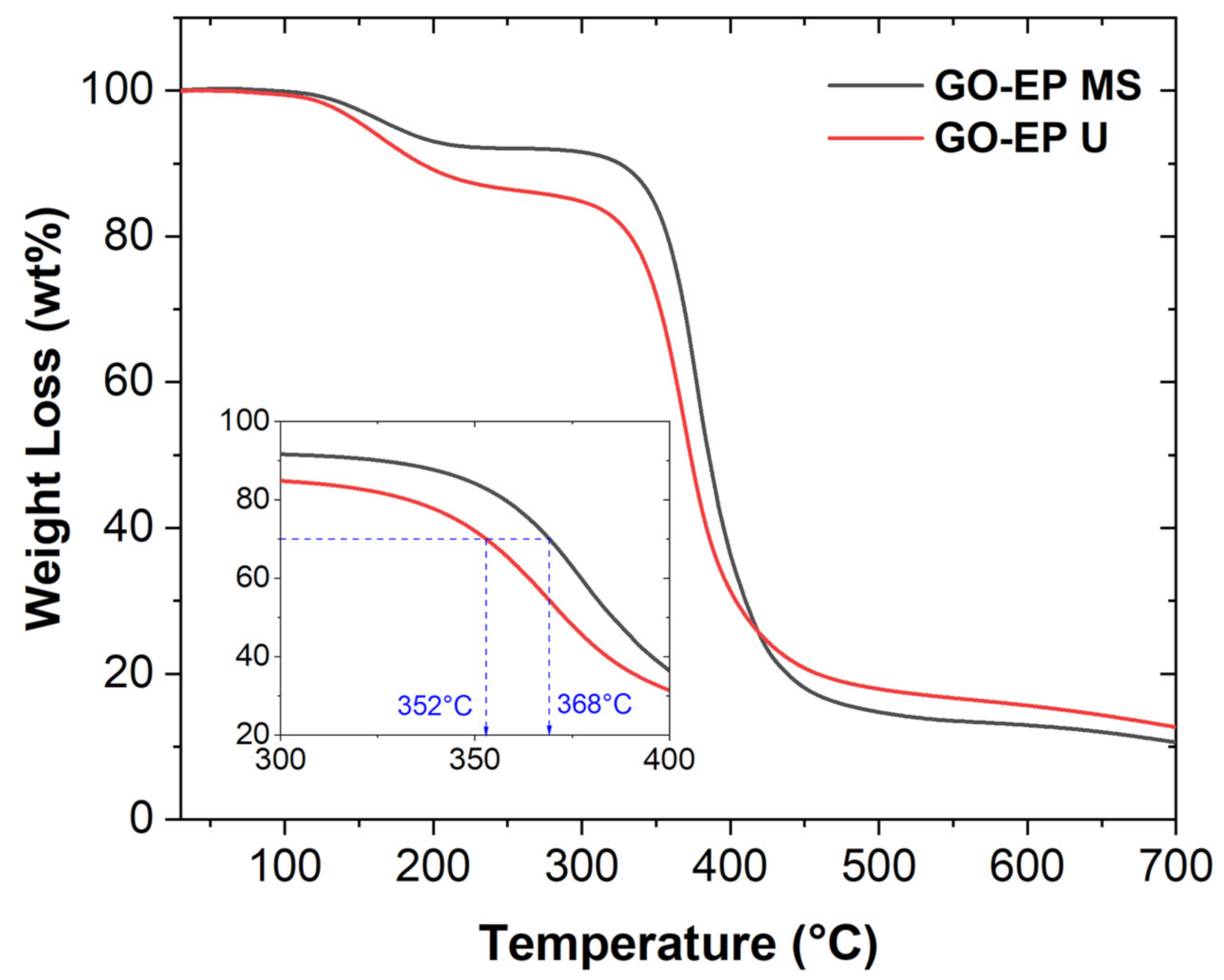
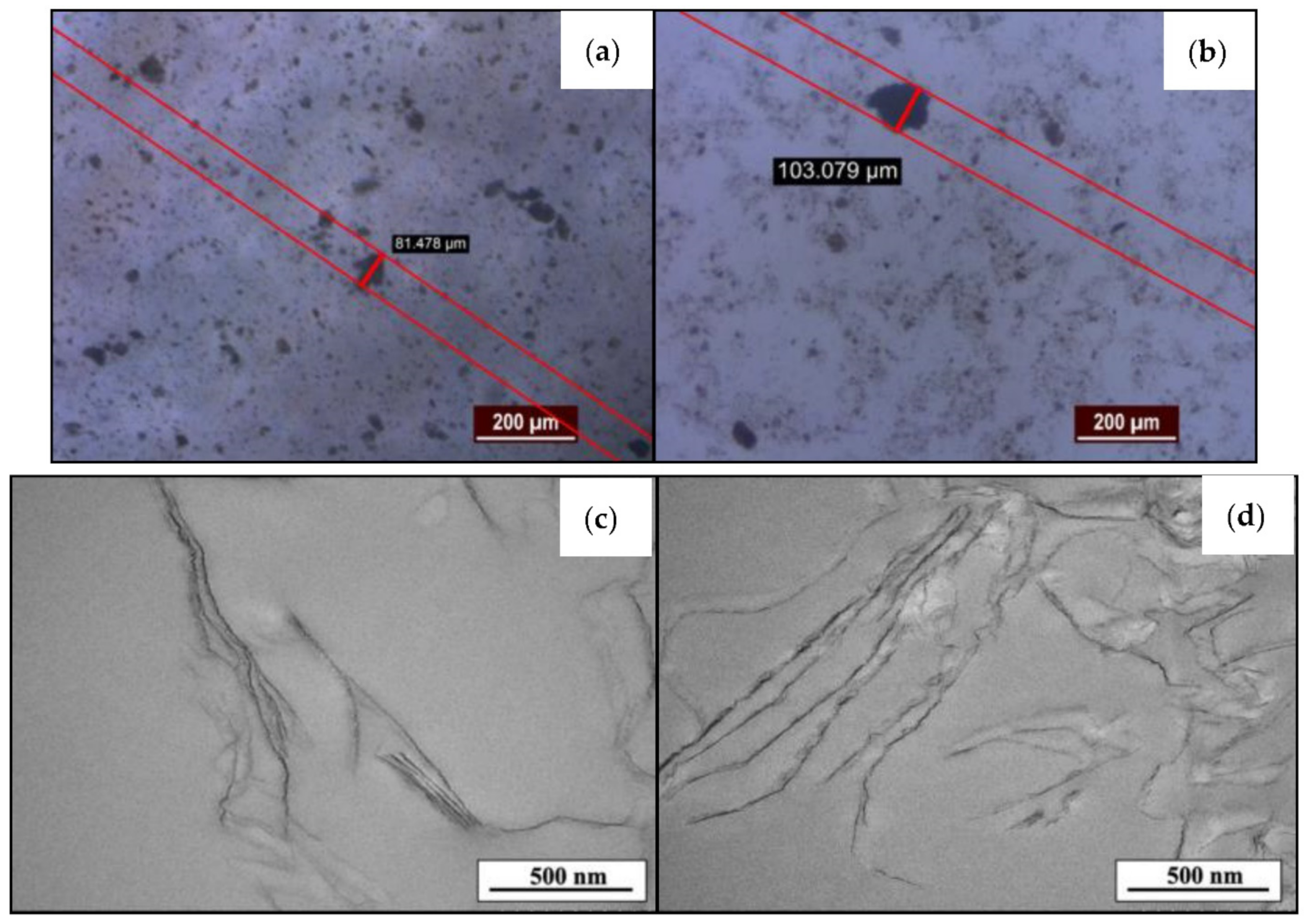


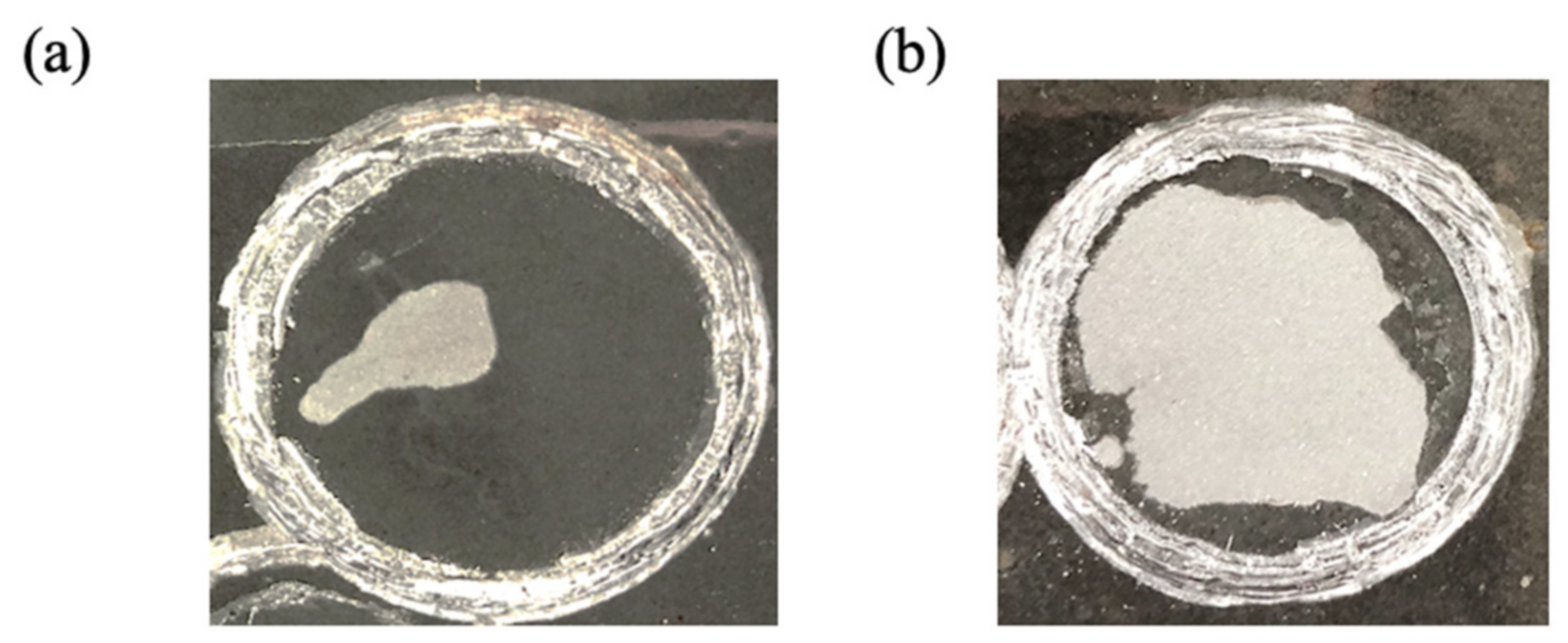
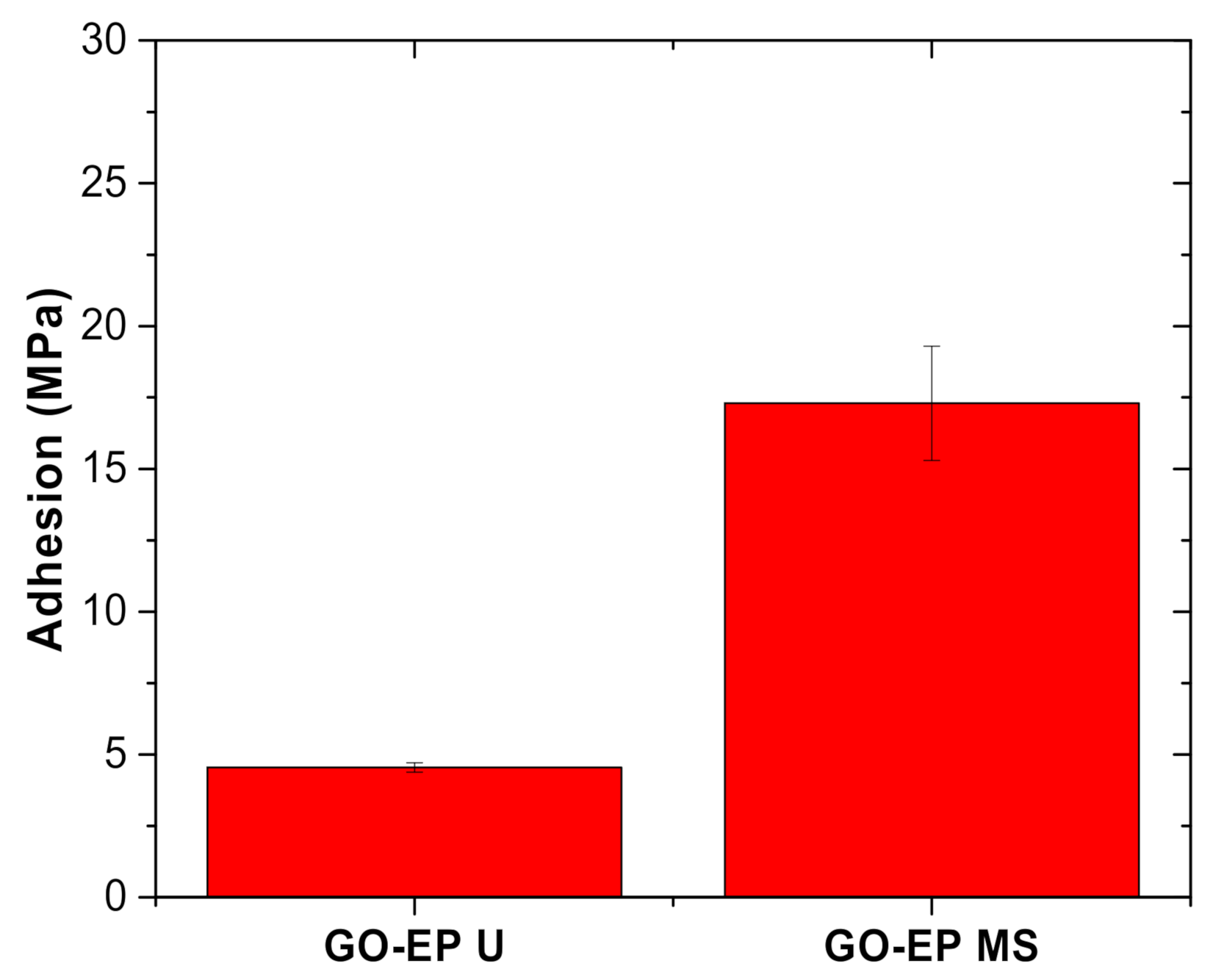



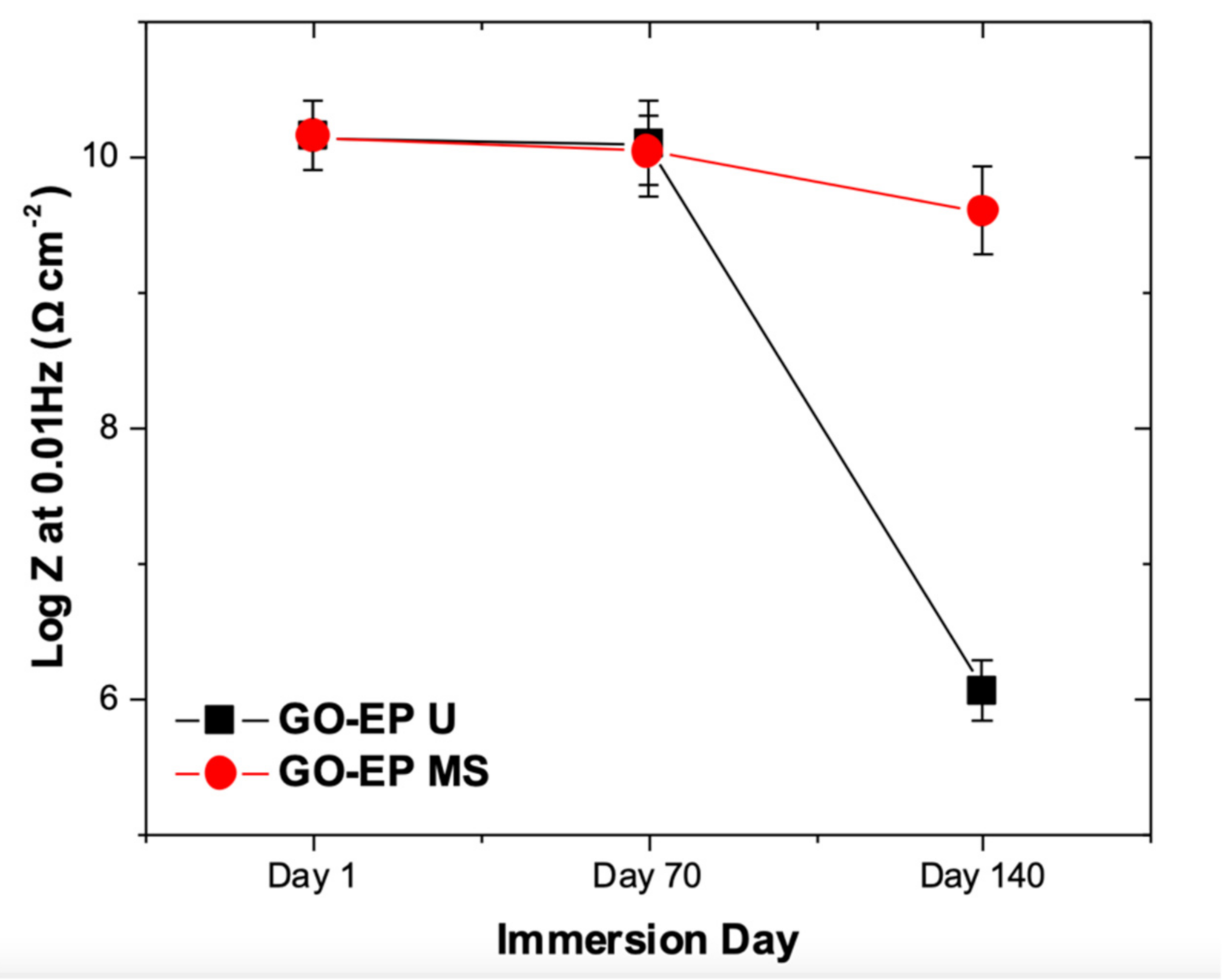
| Sample | Shore A Hardness | Standard Deviation (%) |
|---|---|---|
| GO−EP U | 56 | 7 |
| GO−EP MS | 63 | 6 |
| Sample | Immersion Days | Rc (Ω cm−2) | CPEc | Wc (Ω cm2) | |
|---|---|---|---|---|---|
| Y0 (Ω−1 cm−2 sn) | n | ||||
| GO−EP U | 1 | 2.5 × 1010 | 9.08 × 10−11 | 0.948 | − |
| 70 | 2 × 1010 | 1.07 × 10−10 | 0.938 | − | |
| 140 | 8.5 × 105 | 1.49 × 10−10 | 0.938 | 7 × 10−6 | |
| GO−EP MS | 1 | 2.72 × 1010 | 8.22 × 10−11 | 0.932 | − |
| 70 | 1.31 × 1010 | 5.14 × 10−11 | 0.948 | − | |
| 140 | 6.13 × 109 | 6.28 × 10−11 | 0.928 | − | |
Publisher’s Note: MDPI stays neutral with regard to jurisdictional claims in published maps and institutional affiliations. |
© 2022 by the authors. Licensee MDPI, Basel, Switzerland. This article is an open access article distributed under the terms and conditions of the Creative Commons Attribution (CC BY) license (https://creativecommons.org/licenses/by/4.0/).
Share and Cite
Othman, N.H.; Mustapha, M.; Sallih, N.; Ahmad, A.; Mustapha, F.; Ismail, M.C. The Effect of Residual Solvent in Carbon−Based Filler Reinforced Polymer Coating on the Curing Properties, Mechanical and Corrosive Behaviour. Materials 2022, 15, 3445. https://doi.org/10.3390/ma15103445
Othman NH, Mustapha M, Sallih N, Ahmad A, Mustapha F, Ismail MC. The Effect of Residual Solvent in Carbon−Based Filler Reinforced Polymer Coating on the Curing Properties, Mechanical and Corrosive Behaviour. Materials. 2022; 15(10):3445. https://doi.org/10.3390/ma15103445
Chicago/Turabian StyleOthman, Nurul Husna, Mazli Mustapha, Nabihah Sallih, Azlan Ahmad, Faizal Mustapha, and Mokhtar Che Ismail. 2022. "The Effect of Residual Solvent in Carbon−Based Filler Reinforced Polymer Coating on the Curing Properties, Mechanical and Corrosive Behaviour" Materials 15, no. 10: 3445. https://doi.org/10.3390/ma15103445






